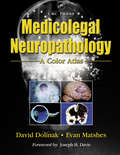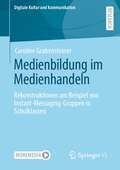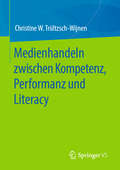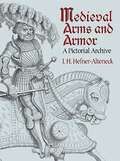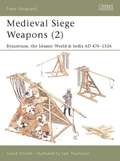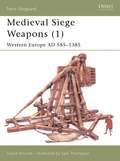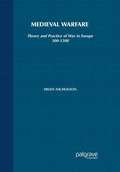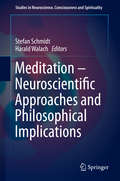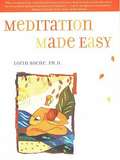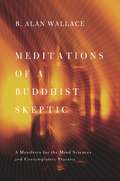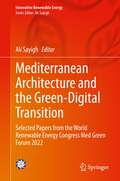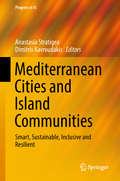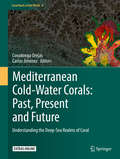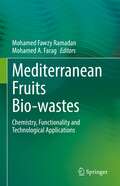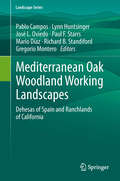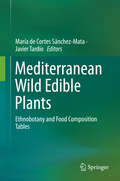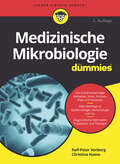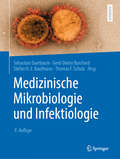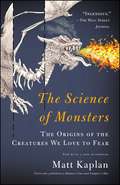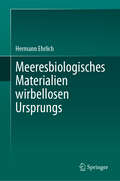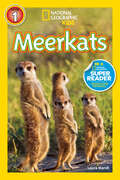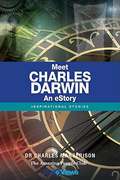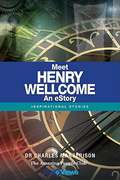- Table View
- List View
Medicolegal Neuropathology: A Color Atlas
by Evan W. Matshes David DolinakWith nearly 600 autopsy photographs, this atlas shows various trauma and diseases of the brain and spinal cord in the forensic context of sudden death investigation. It also provides a simple, straight forward, concise text organized in a primarily case-oriented format. Unlike most other neuropathology texts, attention is given to skull fractures and scalp injuries. Where necessary, radiologic and microscopic images have also been included to facilitate learning along with a brief general anatomy of the brain and spinal cord. Thus pathologists who are not specialized in neuropathology can compare a variety of autopsy findings with cases illustrated in the text.
Medienbildung im Medienhandeln: Rekonstruktionen am Beispiel von Instant-Messaging-Gruppen in Schulklassen (Digitale Kultur und Kommunikation #11)
by Caroline GrabensteinerWie entfaltet sich Bildung angesichts der Handlungsmöglichkeiten in digitalen Medien? In dieser Grounded-Theory Studie werden Fragen zu Medienbildung und Medienhandeln verknüpft. Das Phänomen Instant-Messaging-Gruppen in Schulklassen steht im Zentrum der Analyse. Ergebnis ist ein Theoriemodell zur Rekonstruktion der Herstellung von Selbst- und Weltrelationen auf materialer, sozialer und biografischer Ebene im Prozess der Konstruktion von Handlungskontexten, Themen und sozialen Praktiken der Medienkommunikation mit dem Potenzial zur Erweiterung auf andere Soziale Medien.
Medienhandeln zwischen Kompetenz, Performanz und Literacy
by Christine W. Trültzsch-WijnenDas Buch diskutiert die soziale und individuelle Bedingtheit von Medienkompetenz. Im Mittelpunkt steht die Frage, wie sich das Medienhandeln von Individuen im Hinblick auf deren Medienkompetenz, im Sinne eines sicheren und selbstbestimmten Handelns im Umgang mit Medien, erklären und beurteilen lässt. Dies setzt eine Betrachtung des Medienhandelns vor dem Hintergrund der Beziehungen zwischen der Kompetenz zu Handeln, als Summe von Fähigkeiten, Fertigkeiten und Wissen sowie der kognitiven Beherrschung von Regeln des Verhaltens (moralische Regeln, rechtliche Regeln sowie Regeln der Klugheit), und der Performanz, als tatsächliches Handeln eines Individuums, voraus. Dabei wird auf theoretischer Ebene der Frage nach der sozialen Determinierung eines selbstbestimmten Handelns im Umgang mit Medien einschließlich dafür erforderlicher Fähigkeiten, Fertigkeiten sowie des damit verbundenen Wissens nachgegangen. Außerdem wird das Verhältnis des deutschsprachigen Medienkompetenzdiskurses zum internationalen Diskurs über media literacy erläutert. Es werden Gemeinsamkeiten und Unterschiede herausgearbeitet und Potentiale für eine gegenseitige Befruchtung beider Perspektiven aufgezeigt. Darüber hinaus wird die empirische Relevanz und Anwendbarkeit dieser theoretischen Überlegungen anhand zweier Studien illustriert.
Medieval Arms and Armor: A Pictorial Archive
by J. H. Hefner-AlteneckA renowned 19th-century cultural historian and specialist on the Middle Ages, J. H. Hefner-Alteneck spent much of his life observing the influence of art on many aspects of human life, including weaponry. His illustrations for this handsome archive — drawn with incredible exactitude — depict a wide array of medieval weapons and armor dating from the early ninth century to the mid-1700s.Adapted primarily from decorative ornamentation on burial monuments and manuscripts, hundreds of finely executed images depict authentic shields, swords, crossbows, helmets, and highly ornate suits of body armor for knights and their steeds. Newly translated descriptive notes, extracted from the original German text, identify the subjects. First published more than 100 years ago, this meticulously rendered study remains an invaluable source of permission-free illustrations for artists and designers and an indispensable reference for scholars, collectors, and hobbyists.
Medieval Science
by David C. Lindberg Michael H. ShankThis volume in the highly respected Cambridge History of Science series is devoted to the history of science in the Middle Ages from the North Atlantic to the Indus Valley. Medieval science was once universally dismissed as non-existent - and sometimes it still is. This volume reveals the diversity of goals, contexts and accomplishments in the study of nature during the Middle Ages. Organized by topic and culture, its essays by distinguished scholars offer the most comprehensive and up-to-date history of medieval science currently available. Intended to provide a balanced and inclusive treatment of the medieval world, contributors consider scientific learning and advancement in the cultures associated with the Arabic, Greek, Latin and Hebrew languages. Scientists, historians and other curious readers will all gain a new appreciation for the study of nature during an era that is often misunderstood.
Medieval Siege Weapons: Byzantium, the Islamic World & India AD 476-1526
by David NicolleDuring medieval era, the pre-existing military-technological traditions from the ancient worlds were brought together. Three civilizations were primarily responsible for this evolution: the Late-Roman or Byzantine Empire, the Islamic World, and latterly the Mongol 'World Empire'. This book examines the resulting stone-throwing machines from torsion 'energy storage' systems, to manpowered and counterbalance sling devices, rockets and others.
Medieval Siege Weapons: Western Europe AD 585-1385
by David NicolleThis text explores a range of devices and details the changes in medieval siege warfare brought about by the mixing of traditions from Greece, Rome, Persia, India and China.
Medieval Warfare: Theory and Practice of War in Europe 300–1500
by Helen NicholsonWarfare in medieval times was never static or predictable - although there were ideals and conventions to follow, in the field commanders had to use their initiative and adapt to the needs of the moment. In this concise, wide-ranging study, Helen Nicholson provides the essential introductory guide to a fascinating subject. Medieval Warfare - surveys and summarises current debates and modern research into warfare throughout the whole of the medieval period across Europe - sets medieval warfare theory and practice firmly into context as a continuation and adaptation of practice under the Roman Empire, tracing its change and development across more than a millennium - considers military personnel, buildings and equipment, as well as the practice of warfare by land and sea
Meditation - Neuroscientific Approaches and Philosophical Implications
by Harald Walach Stefan SchmidtThis volume features a collection of essays on consciousness, which has become one of the hot topics at the crossroads between neuroscience, philosophy, and religious studies. Is consciousness something the brain produces? How can we study it? Is there just one type of consciousness or are there different states that can be discriminated? Are so called "higher states of consciousness" that some people report during meditation pointing towards a new understanding of consciousness? Meditation research is a new discipline that shows new inroads into the study of consciousness. If a meditative practice changes brain structure itself this is direct proof of the causal influence of consciousness onto its substrate. If different states of consciousness can be linked with properties and states of the brain this can be used to study consciousness more directly. If the sense of self is modifiable through meditative techniques and this can be objectively shown through neuro-imaging, this has profound implications for our understanding of who we are. Can consciousness, in deep states of meditative absorption, actually access some aspect of reality which we normally don't? Meditation research can potentially foster us with a new access to the phenomenological method in general. This has even been branded with a new catch-phrase: Contemplative Science. It brings together the most modern neuroscientific approach and the most advanced phenomenological methodology of studying the mind from within, through highly skilled self-observation that has gone through many thousand hours of honing the capacity to look carefully, without distraction. This book addresses these issues by bringing together some of the leading researchers and thinkers in the field. The scope of the volume reaches from first person neuroscience to Indian philosophy, from pedagogic applications to epistemological aspects and from compassion meditation to the study of brain activity.
Meditation Made Easy
by Camille Maurine Lorin RocheTips on how to make meditation simple and pleasurable. Provides info on creating mini meditations, overcoming boredom and racing thoughts, customizing personal practices, and more.
Meditations of a Buddhist Skeptic: A Manifesto for the Mind Sciences and Contemplative Practice
by B. Alan WallaceA scholar of both spirituality and science proposes a radical approach to studying the mind with the goal of restoring human nature—and transcending it. Renowned Buddhist philosopher B. Alan Wallace reasserts the power of shamatha and vipashyana, traditional Buddhist meditations, to clarify the mind's role in the natural world. Raising profound questions about human nature, free will, and experience versus dogma, Wallace challenges the claim that consciousness is nothing more than an emergent property of the brain with little relation to universal events. Rather, he maintains that the observer is essential to measuring quantum systems and that mental phenomena (however conceived) influence brain function and behavior. Wallace embarks on a two-part mission: to restore human nature and to transcend it. He begins by explaining the value of skepticism in Buddhism and science and the difficulty of merging their experiential methods of inquiry. Yet Wallace also proves that Buddhist views on human nature and the possibility of free will liberate us from the metaphysical constraints of scientific materialism. He then explores the radical empiricism inspired by William James and applies it to Indian Buddhist philosophy's four schools and the Great Perfection school of Tibetan Buddhism. Since Buddhism begins with the assertion that ignorance lies at the root of all suffering and that the path to freedom is reached through knowledge, Buddhist practice can be viewed as a progression from agnosticism (not knowing) to gnosticism (knowing), acquired through the maintenance of exceptional mental health, mindfulness, and introspection. Wallace discusses these topics in detail, identifying similarities and differences between scientific and Buddhist understanding, and he concludes with an explanation of shamatha and vipashyana and their potential for realizing the full nature, origins, and potential of consciousness. &“His range and depth of knowledge is astounding, and his linking of this knowledge to the practices and views of science is unique.&” —Arthur Zajonc, author of Catching the Light
Mediterranean Architecture and the Green-Digital Transition: Selected Papers from the World Renewable Energy Congress Med Green Forum 2022 (Innovative Renewable Energy)
by Ali SayighThis book contains selected papers presented during the World Renewable Energy Network’s biannual World Med Green Forum (MGF). The 2022 MGF highlights the role of renewable energy applications in the sustainable building sector with a focus on the Mediterranean region as a foundation for a truly positive energy future. MGF is an open roundtable for an international community of researchers, practitioners, and experts to discuss the most innovative and promising sustainable building technologies. The papers presented explore the intersection between twin transitions in policies, programs, projects, and experimentation, with the digital domain innovating the green building sector towards more reliable and inclusive planning and design practices in order to collectively envision future buildings and cities.
Mediterranean Cities and Island Communities: Smart, Sustainable, Inclusive and Resilient (Progress in IS)
by Anastasia Stratigea Dimitris KavroudakisThis book addresses the issue of smart and sustainable development in the Mediterranean (MED) region, a distinct part of the world, full of challenges and risks but also opportunities. Above all, the book focuses on smartening up small and medium-sized cities and insular communities, taking into account their geographical peculiarities, the pattern of MED urban settlements and the abundance of island complexes in the MED Basin. Taking for granted that sustainability in the MED is the overarching policy goal that needs to be served, the book explores different aspects of smartness in support of this goal’s achievement. In this respect, evidence from concrete smart developments adopted by forerunners in the MED region is collected and analyzed; coupled with experiences gathered from successful, non-MED, examples of smart efforts in European countries. More specifically, current research and empirical results from MED urban environments are discussed, as well as findings from or concerning other parts of the world, which are of relevance to the MED region. The book’s primary goal is to enable policymakers, planners and decision-making bodies to recognize the challenges and options available; and make to more informed policy decisions towards smart, sustainable, inclusive and resilient urban and regional futures in the MED.
Mediterranean Cold-Water Corals: Understanding the Deep-Sea Realms of Coral (Coral Reefs of the World #9)
by Covadonga Orejas Carlos JiménezWhat do we know about Mediterranean Cold (Deep)-Water coral ecosystems? In this book, specialists offer answers and insights with a series of chapters and short papers about the paleoecology, biology, physiology and ecology of the corals and other organisms that comprise these ecosystems. Structured on a temporal axis—Past, Present and Future—the reviews and selected study cases cover the cold and deep coral habitats known to date in the Mediterranean Basin. This book illustrates and explains the deep Mediterranean coral habitats that might have originated similar thriving ecosystems in today’s Atlantic Ocean.
Mediterranean Fruits Bio-wastes: Chemistry, Functionality and Technological Applications
by Mohamed Fawzy Ramadan Mohamed A. FaragTraditional Mediterranean fruits (i.e., be grapes, oranges, apples, pears, peaches, cherries, plums, figs, melons, watermelon and dates) are of major commercial and nutritional value to the region. Processing of such fruits, however, results in large amounts of bio-waste material. Efficient, inexpensive and environmentally friendly use of fruit industry waste is thus highly cost-effective and minimizes environmental impact. The natural antioxidants and bioactive compounds found in Mediterranean fruit bio-wastes could play a major role in the alleged health benefits of the Mediterranean diet, and could be used in pharmaceuticals as well as novel food applications. This book presents a multidisciplinary forum of discussion on the chemistry, functional properties and health-promoting effects of bioactive compounds in Mediterranean fruit bio-wastes, as well as novel food and non-food applications. The text provides the scientific fundamentals of the health-promoting benefits and applications of Mediterranean fruit bio-wastes, reviews the relevant recovery issues and explores different techniques to develop new applications. With a diversity of perspectives, from food science to environmental chemistry and horticultural research, this volume provides comprehensive, up-to-date knowledge to researchers and industry professionals working in the areas of food waste valorization.
Mediterranean Oak Woodland Working Landscapes
by Gregorio Montero Jose Luis Oviedo Pro Lynn Huntsinger Mario Diaz Pablo Campos Paul F Starrs Richard B StandifordThe oak tree was a boon companion as humans expanded their presence across much of the globe. While oak woodlands (Quercus spp.) come today in stunningly diverse forms, the stately dehesas of Spain and the dramatic oak-dominated ranchlands of California are working landscapes where cultivation and manipulation for a couple of millennia have shaped Mediterranean-type ecosystems into a profoundly modified yet productive environment that is sought-after by every manner of species. The grazing of wildlife and livestock in oak woodlands yields a remarkable plant and animal biodiversity, creating a mosaic of habitats and visually pleasing savannas. Added products unique to Spain such as Iberian pigs and cork, and in California multiple landowner benefits, include valued ecosystem services that allow owners, visitors, and conservation supporters to experience the benefits of woodland life. With its 15 chapters a decade in the making, this handsomely illustrated book covers key topics in oak woodland policy, ecology, and management in Spain and California, presenting new research results and reviewing an existing expert literature.
Mediterranean Wild Edible Plants
by María de Cortes Sánchez-Mata Javier TardíoThis book is the result of collaboration between botanists and food chemists, with the purpose of improving the knowledge of the main wild species of traditional use as foods in the Mediterranean area, focus on ethnobotanical aspects, natural production, uses and nutritional aspects. One of the novelties of the book would be the publication of complete food composition tables of at least 50 species, which are not usually included in nutrient databases of foods. Many of the data included would come from the chemical analysis of representative samples of these species and other would be compiled from the scientific literature. Since this topic has not been fully studied, this book would provide an interesting tool to be used with the purpose of the revalorization of wild food species, preservation of their traditional uses, and also as alternatives to improve the diversity of modern Mediterranean diets.
Medizinische Mikrobiologie für Dummies (Für Dummies)
by Ralf-Peter Vonberg Christina HaeseKokken, Stäbchen, Pilze, Viren, Prionen, Parasiten und Co. ? die Medizinische Mikrobiologie ist komplex und vielfältig. Aber keine Sorge, Ralf-Peter Vonberg und Christina Haese führen Sie Schritt für Schritt in die mikrobiologische Welt ein und erklären Ihnen alles, was Sie über pathogene Mikroorganismen und deren Bekämpfung wissen müssen. Dabei erläutern sie klar strukturiert das Wichtigste über Prävention, Diagnose und Behandlung von Infektionskrankheiten und richten sich dabei nach dem IMPP-Gegenstandskatalog.
Medizinische Mikrobiologie für Dummies (Für Dummies)
by Ralf-Peter Vonberg Christina HaeseKokken, Stäbchen, Pilze, Viren, Prionen, Parasiten und Co. - die Medizinische Mikrobiologie ist komplex und vielfältig. Aber keine Sorge, Ralf-Peter Vonberg und Christina Haese führen Sie Schritt für Schritt in die mikrobiologische Welt ein und erklären Ihnen alles, was Sie über pathogene Mikroorganismen und deren Bekämpfung wissen müssen. Dabei erläutern sie klar strukturiert das Wichtigste über Prävention,Diagnose und Behandlung von Infektionskrankheiten und richtensich dabei nach dem IMPP-Gegenstandskatalog.
Medizinische Mikrobiologie und Infektiologie (Springer-lehrbuch Ser.)
by Sebastian Suerbaum Gerd-Dieter Burchard Thomas F. Schulz Stefan H. E. KaufmannIn diesem Lehrbuch wird die medizinische Mikrobiologie von den allgemeinen Grundlagen über die Immunologie, die Diagnostik bis hin zur Chemotherapie dargestellt. Dabei sind die Kapitel zu den einzelnen Erregern besonders übersichtlich gestaltet. Um den klinischen Bezug deutlich zu machen, gibt es eine eigene große Sektion zu den Krankheitsbildern. Ein durchdachtes Konzept macht das Lernen leicht: Erreger-Steckbriefe zum schnellen LernenFallbeispieleZusammenfassungen am KapitelendeZahlreiche klinische AbbildungenEnge Vernetzung zwischen Erreger-Kapiteln und den Krankheitsbildern durch viele Querverweise Sämtliche Teilbereiche des Fachgebietes sind enthalten: Grundlagen, Immunologie, Diagnostik, Epidemiologie, Prävention, Hygiene, Bakteriologie, Virologie, Mykologie, Parasitologie, Chemotherapie, wichtige KrankheitsbilderDie HerausgeberProfessor Sebastian Suerbaum ist Vorstand des Lehrstuhls für Medizinische Mikrobiologie und Krankenhaushygiene am Max von Pettenkofer-Institut der Ludwig-Maximilians-Universität München Professor Gerd-Dieter Burchard ist tätig im Bernhard-Nocht-Institut für Tropenmedizin in Hamburg.Professor Thomas Schulz ist Direktor des Instituts für Virologie der Medizinischen Hochschule HannoverProfessor Stefan H.E. Kaufmann ist Direktor am Max-Planck-Institut für Infektionsbiologie in Berlin.
Medusa's Gaze and Vampire's Bite
by Matt KaplanWe all know "there's no such thing as monsters," but our imaginations tell us otherwise. From the mythical beasts of ancient Greece to the hormonal vampires of the Twilight saga, monsters have captivated us for millennia. Matt Kaplan, a noted science journalist and monster-myth enthusiast, employs an entertaining mix of cutting-edge research and a love of lore to explore the history behind these fantastical fictions and our hardwired obsession with things that go bump in the night. Ranging across history, Medusa's Gaze and Vampire's Bite tackles the enduring questions that arise on the frontier between fantasy and reality. What caused ancient Minoans to create the tale of the Minotaur and its subterranean maze? Did dragons really exist? What inspired the creation of vampires and werewolves, and why are we so drawn to them? With the eye of a journalist and the voice of a storyteller, Kaplan takes readers to the forefront of science, where our favorite figures of horror may find real-life validation. Does the legendary Kraken, a squid of epic proportions, really roam the deep? Are we close to making Jurassic Park a reality by replicating a dinosaur from fossilized DNA? As our fears evolve, so do our monsters, and Medusa's Gaze and Vampire's Bite charts the rise of the ultimate beasts, humans themselves.
Meeresbiologisches Materialien wirbellosen Ursprungs
by Hermann EhrlichDas Buch Das Werk ist eine Quelle für modernes Wissen über Biomineralisation, Biomimetik und bioinspirierte Materialwissenschaft in Bezug auf wirbellose Meerestiere. Der Autor liefert die kohärenteste Analyse der Natur, des Ursprungs und der Entwicklung von Biokompositen und Biopolymeren, die aus der großen Vielfalt der wirbellosen Meeresorganismen isoliert und in deren ungewöhnlichen Strukturformationen beobachtet wurden. Das grundlegende Format ist das eines großen Übersichtsartikels, mit großzügiger Verwendung von Verweisen auf die Originalliteratur. Das Buch enthält eine Fülle neuer und neu zusammengestellter Informationen, darunter Dutzende von bisher unveröffentlichten Bildern einzigartiger mariner Lebewesen und Strukturen vom Nano- bis zum Mikrobereich, einschließlich hochauflösender Raster- und Transmissionselektronenmikroskopaufnahmen. Das Material ist sowohl nach biologischen (Phyla) als auch nach funktionellen Gesichtspunkten geordnet. Es wird eine Klassifizierung der biologischen Materialien marinen Ursprungs vorgeschlagen und diskutiert. Ein Großteil der einschlägigen Daten ist in Tabellen organisiert, und es wird ausgiebig Gebrauch von elektronenmikroskopischen Aufnahmen und Strichzeichnungen gemacht. Mehrere moderne Themen, wie z.B. "Biomineralisierungs-, Demineralisierungs- und Remineralisierungsphänomene" oder "Phänomene der mehrphasigen Biomineralisation", werden ausführlich diskutiert. Traditionell werden aktuelle Konzepte wie die hierarchische Organisation von Biokompositen und Skelettstrukturen, strukturelle Biogerüste, Bioskulpturierung, Biomimetismus und Bioinspiration als Werkzeuge für das Design innovativer Materialien sowohl aus biologischer als auch aus materialwissenschaftlicher Sicht anhand zahlreicher einzigartiger Beispiele marinen Ursprungs kritisch analysiert. Diese Monographie gibt einen Überblick über die wichtigsten Fortschritte auf dem Gebiet der marinen Biomaterialien und zeigt mehrere Ansätze auf, die von verschiedenen Labors eingeführt und erforscht werden."
Meerkats (Readers)
by Laura MarshWelcome to the wacky world of meerkats, where groups of these furry friends team up to survive in the wild. Each meerkat has a job: babysitting the kids, guarding the troops, or foraging for food. Kids will be mesmerized by wonderful photographs and inviting text. This level 1 reader is written in easy-to-grasp text that will help kids learn about these cute critters and the power of teamwork!
Meet Charles Darwin - An eStory
by Charles MargerisonMeet Charles Darwin, responsible for the theory of natural selection and author of On Origin of the Species. Darwin is arguably one of the most influential characters in world history, in that he redefined so many pre-conceived ideas. He was far ahead of his time. His amazing life comes alive through BioViews. You can follow the young Darwin from his early years, when his mother died, to his medical studies where his curiosity in natural order and development sent him off on explorations that would ultimately change the way the world is regarded.A BioView® is a short biographical story, similar to an interview. These unique audio stories provide an easy way of learning about amazing people who made major contributions to our world.
Meet Henry Wellcome - An eStory
by Charles MargerisonMeet Henry Wellcome. Discover his amazing life story in this unique audio story from The Amazing People Club. He may have saved your life with the medicines he developed and produced. Henry willed his entire fortune to further development and research to The Wellcome Trust, which is one of the largest biomedical charities in the world. Travel with Henry Wellcome from the log cabin in which he was born in Wisconsin on his epic journeys around the world, driven by his thirst for knowledge and insatiable curiosity. Henry Wellcome's story comes to life through BioViews®. These are short biographical narratives, similar to interviews. They provide an easy way of learning about amazing people who made major contributions and changed our world.
